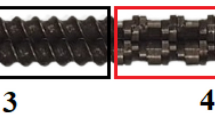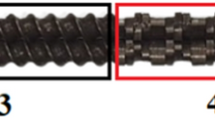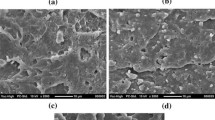Abstract
The effect of four mixing protocols was investigated in blends of polystyrene (PS) with recycled copolymer polypropylene (PPr), using 10% by weight of styrene-(ethylene-butylene)-styrene (SEBS) as a compatibilizing agent. The polymeric blends were processed in a co-rotational twin-screw extruder and injection molded. The melt flow index (MFI), Izod impact strength, tensile strength, Shore D hardness, differential scanning calorimetry (DSC), thermogravimetry (TG) properties, and scanning electron microscopy (SEM) were evaluated. The MFI indicated that when incorporating SEBS into the PS/PPr system, the fluidity was reduced, suggesting that the level of molecular entanglement increased, confirming the expressive results of impact strength and elongation at break. When PS and SEBS were blended in a first extrusion, before the incorporation of PPr in a second extrusion, there were gains of 541% and 814.3% in impact strength and elongation at break compared to pure PS, respectively. On the other hand, pre-mixing PPr and SEBS, before adding PS in the second extrusion step, reduced the toughening effectiveness. Simultaneous mixing of all PS/PPr/SEBS components, in a single extrusion, showed the best balance of mechanical properties and increased thermal stability. The selective dispersion of SEBS in the PS/PPr blend affected the degree of refinement as verified in the morphology obtained by SEM directly reflecting on the mechanical properties. The results showed that using SEBS as a compatibilizer, PPr can be used as an impact modifier of the brittle PS matrix, generating a tough material.











Similar content being viewed by others
References
Hossain R, Islam MT, Shanker R, Khan D, Locock KES, Ghose A, Schandl H, Dhodapkar R, Sahajwalla V (2022) Plastic waste management in India: Challenges, opportunities, and roadmap for circular economy. Sustainability 14(8):4425. https://doi.org/10.3390/su14084425
Zhu Z, Liu W, Ye S, Ye S, Batista L (2022) Packaging design for the circular economy: A systematic review. Sustainable Production and Consumption 32:817–832. https://doi.org/10.1016/j.spc.2022.06.005
Luna CBB, Ferreira ESB, Costa ARM, Almeida YMB, Melo JBCA, Araújo EM (2023) Toward reactive processing of polyamide 6 based blends with polyethylene grafted with maleic anhydride and acrylic acid: Effect of functionalization degree. Macromol React Eng 2300031. https://doi.org/10.1002/mren.202300031
Kusenberg M, Eschenbacher A, Delva L, Meester S, Delikonstantis E, Stefanidis GD, Ragaert K, Geem KMV (2022) Towards high-quality petrochemical feedstocks from mixed plastic packaging waste via advanced recycling: The past, present and future. Fuel Process Technol 238:107474. https://doi.org/10.1016/j.fuproc.2022.107474
Silva N, Palsson H (2022) Industrial packaging and its impact on sustainability and circular economy: A systematic literature review. J Clean Prod 333:130165. https://doi.org/10.1016/j.jclepro.2021.130165
Benyathiar P, Kumar P, Carpenter G, Brace J, Mishra DK (2022) Polyethylene terephthalate (PET) bottle-to-bottle recycling for the beverage industry: a review. Polymers 14(12):2366. https://doi.org/10.3390/polym14122366
Franz R, Welle F (2022) Recycling of post-consumer packaging materials into new food packaging applications—critical review of the European approach and future perspectives. Sustainability 14(2):824. https://doi.org/10.3390/su14020824
Khan SU, Hassan T, Wasim M, Khan MQ, Salam A, Hassan ZU, Abbasi AMR, Mustafa T (2023) Valorization of recycled PET for yarn manufacturing and knitwear fabrics used for apparel applications. Polym Bull 80:2779–2799. https://doi.org/10.1007/s00289-022-04172-8
Khoaele KK, Gbadeyan OJ, Chunilall V, Sithole B (2023) The devastation of waste plastic on the environment and remediation processes: a critical review. Sustainability 15(6):5233. https://doi.org/10.3390/su15065233
Nogueira JAS, Luna CBB, Nedeiros VN, Wellen RMR, Melo JBCA, Araújo EM (2023) Do descarte ao reaproveitamento do resíduo de estireno-butadieno (SBRr): produção de compostos de PA6/SBRr compatibilizados com SEBS-MA e reforçados com argila montmorilonita. Revista De Gestão E Secretariado 14(5):8452–8474. https://doi.org/10.7769/gesec.v14i5.2221
Meneses RAM, Papamija GC, Martínez FM, Rodríguez LA, Diosa JE, Vargas EM (2022) Plastic recycling and their use as raw material for the synthesis of carbonaceous materials. Heliyon 8(3):e09028. https://doi.org/10.1016/j.heliyon.2022.e09028
Dai L, Ruan S, Lei H (2022) Paths to sustainable plastic waste recycling. Science 377(6609):934. https://doi.org/10.1126/science.ade2221
Luna CBB, Silva FS, Ferreira ESB, Silva AL, Wellen RMR, Araújo EM (2023) Transforming vulcanized styrene–butadiene waste into valuable raw material: an opportunity for high-impact polypropylene production. Polym Bull. https://doi.org/10.1007/s00289-023-04729-1
Costa ARM, Henrique MA, Luna CBB, Carvalho LH, Almeida YMB (2022) Influence of a multifunctional epoxy additive on the performance of polyamide 6 and PET post-consumed blends during processing. Sustainability 14(24):16658. https://doi.org/10.3390/su142416658
Chen HL, Nath TK, Chong S, Foo V, Gibbins C, Lechner AM (2021) The plastic waste problem in Malaysia: management, recycling and disposal of local and global plastic waste. SN Appl Sci 3:437. https://doi.org/10.1007/s42452-021-04234-y
Das SK, Eshkalak SK, Chinnappan A, Ghosh R, Jayathilaka WADM, Baskar C, Ramakrisshna S (2021) Plastic recycling of polyethylene terephthalate (PET) and polyhydroxybutyrate (PHB)—a comprehensive review. Mater Circ Econ 3:9. https://doi.org/10.1007/s42824-021-00025-3
Luna CBB, Siqueira DD, Araújo EM, Nascimento EP, Melo JBCA (2022) Evaluation of the SEBS copolymer in the compatibility of PP/ABS blends through mechanical, thermal, thermomechanical properties, and morphology. Polym Adv Technol 33(1):111–124. https://doi.org/10.1002/pat.5495
Larsen AG, Olafsen K, Alcock B (2021) Determining the PE fraction in recycled pp. Polym Test 96:107058. https://doi.org/10.1016/j.polymertesting.2021.107058
Cestari SP, Martin PJ, Hanna PR, Kearns MP, Mendes LC, Millar B (2021) Use of virgin/recycled polyethylene blends in rotational moulding. J Polym Eng 41(6):509–516. https://doi.org/10.1515/polyeng-2021-0065
Schyns ZOG, Shaver MP (2021) Mechanical recycling of packaging plastics: a review. Macromol Rapid Commun 42(3):2000415. https://doi.org/10.1002/marc.202000415
Luna CBB, Ferreira ESB, Silva LJMD, Silva WA, Araújo EM, Melo TJA (2019) Blends with technological potential of copolymer polypropylene with polypropylene from post-consumer industrial containers. Mater Res Express 6(12):125319. https://doi.org/10.1088/2053-1591/ab56b2
Adeniyi AG, Abdulkareem SA, Adeoye SA, Ighalo JO (2022) Preparation and properties of wood dust (isoberlinia doka) reinforced polystyrene composites. Polym Bull 79:4361–4379. https://doi.org/10.1007/s00289-021-03718-6
Adeniyi AG, Abdulkareem SA, Adeyanju CA, Abdulkareem MT, Odimayomi KP, Iwuozor KO, Amoloye MA, Belgore RO (2022) Production and properties of the fibrillated plastic composite from recycled polystyrene and Luffa cylindrica. Polym Bull. https://doi.org/10.1007/s00289-022-04511-9
Luna CBB, Silva DF, Araújo EM, Mélo TJA, Bezerra EOT, Siqueira DD, Oliveira AD (2019) Blends of polystyrene/shoes waste (SBRr): Influence of mixture sequence and compatibilizer. Macromol Symp 383(1):1800046. https://doi.org/10.1002/masy.201800046
Luna CBB, Silva DF, Araújo EM, Mélo TJA, Oliveira AD (2016) Efeito dos agentes de compatibilização SBS e SEBS-MA no desempenho de misturas de poliestireno/resíduo de borracha de SBR. Matéria (Rio J) 21(3):632–646. https://doi.org/10.1590/S1517-707620160003.0061
Coutinho FMB, Costa MPM, Guimarães MJOC, Soares BG (2008) Preparation and characterization of high-impact polystyrene using different types of polybutadiene. J Appl Polym Sci 108(1):406–413. https://doi.org/10.1002/app.27656
Pichioni F, Aglietto M, Passaglia E, Ciardelli F (2002) Blends of syndiotactic polystyrene with SEBS triblock copolymers. Polymer 43(11):3323–3329. https://doi.org/10.1016/S0032-3861(02)00103-9
Libio IC, Grassi VG, Pizzol MFD, Nachtigall SMB (2012) Toughened polystyrene with improved photoresistance: Effects of the compatibilizers. J Appl Polym Sci 126(1):179–185. https://doi.org/10.1002/app.36546
Tang LW, Tam KC, Yue CY, Hu X, Lam YC, Li L (2004) Rheological and mechanical properties of compatibilized polystyrene/ethylene vinyl acetate blends. J Appl Polym Sci 94(5):2071–2082. https://doi.org/10.1002/app.21151
Oliveira RVB, Ferreira CI, Peixoto LJF, Bianchi O, Silva PA, Demori R, Silva RP, Veronese VB (2013) Mistura polipropileno/poliestireno: um exemplo da relação processamento-estrutura-propriedade no ensino de polímeros. Polímeros 23(1):91–96. https://doi.org/10.1590/S0104-14282013005000001
Koning C, Duin MV, Pagnoulle C, Jerome R (1998) Strategies for compatibilization of polymer blends. Prog Polym Sci 23(4):707–757. https://doi.org/10.1016/S0079-6700(97)00054-3
Halimatudahliana A, Ismail H, Nasir M (2002) The effect of various compatibilizers on mechanical properties of polystyrene/polypropylene blend. Polym Test 21(2):163–170. https://doi.org/10.1016/S0142-9418(01)00064-2
Samsudin SA, Hassan A, Jamaluddin SM (2005) Effect of SEBS on the mechanical properties and miscibility of polystyrene rich polystyrene/ polypropylene blends. Prog Rubber Plast Recycl Technol 21(4):261–276. https://doi.org/10.1177/147776060502100402
Luna CBB, Siqueira DD, Ferreira ESB, Silva WA, Nogueira JAS, Araújo EM (2020) From disposal to technological potential: Reuse of polypropylene waste from industrial containers as a polystyrene impact modifier. Sustainability 12(13):5272. https://doi.org/10.3390/su12135272
Halimatudahliana A, Ismail H, Nasir M (2002) Morphological studies of uncompatibilized and compatibilized polystyrene/polypropylene blend. Polym Test 21(3):263–267. https://doi.org/10.1016/S0142-9418(01)00079-4
Huo Y, Groeninckx G, Moldenaers P (2007) Rheology and morphology of polystyrene/polypropylene blends with in situ compatibilization. Rheol Acta 46:507–520. https://doi.org/10.1007/s00397-006-0158-3
Deng S, Zhao X, Huang Y, Han X, Liu H, Hu Y (2011) Deformation and fracture of polystyrene/polypropylene blends: A simulation study. Polymer 52(24):5681–5694. https://doi.org/10.1016/j.polymer.2011.09.050
Horak Z, Kolarik J, Sipek M, Hynek V, Vecerka F (1998) Gas permeability and mechanical properties of polystyrene–polypropylene blends. J Appl Polym Sci 69(13):2615–2623. https://doi.org/10.1002/(SICI)1097-4628(19980926)69:13%3C2615::AID-APP12%3E3.0.CO;2-T
Thirtha V, Lehman R, Nosker T (2005) Glass transition phenomena in melt-processed polystyrene/polypropylene blends. Polym Eng Sci 45(9):1187–1193. https://doi.org/10.1002/pen.20387
Pernusch DC, Spiegel G, Paulik C, Hofer W (2022) Influence of poisons originating from chemically recycled plastic waste on the performance of ziegler-natta catalysts. Macromol React Eng 16(1):2100020. https://doi.org/10.1002/mren.202100020
Silva PTV, Luna CBB, Filho EAS, Nascimento EP, Araújo EM (2023) Tailoring polyamide 6 to exhibit super-tough behavior and high thermomechanical stability: The role of AES and EPDM-MA hybridization. J Appl Polym Sci e54470. https://doi.org/10.1002/app.54470
Pehlivanli ZO (2021) Manufacturing and characterization of polypropylene/boric acid composite. Polym Bull 78:4033–4046. https://doi.org/10.1007/s00289-021-03728-4
Pereira JRD, Bernardes GP, Silva JAP, Bonmann VC, Calcagno CIW, Santana RMC (2021) Structure-property correlation of an impact- modified random polypropylene copolymer. J Elastomers Plast 53(5):450–468. https://doi.org/10.1177/0095244320947765
Aurrekoetxea J, Sarrionandia MA, Urrutibeascoa I, Maspoch ML (2001) Effects of recycling on the microstructure and the mechanical properties of isotactic polypropylene. J Mater Sci 36:2607–2613. https://doi.org/10.1023/A:1017983907260
Santos LS, Silva AHMFT, Pacheco EBAV, Silva ALN (2013) Study of the effect of recycled PP on the mechanical and flow properties of PP/ERDM blends. Polímeros 23(3):389–394. https://doi.org/10.4322/polimeros.2013.083
Abreu FOMS, Forte MMC, Liberman SA (2006) Morphology and mechanical properties of polypropylenes/TPEs blends. Polímeros: Ciência e Tecnologia 16(1):71–78. https://doi.org/10.1590/S0104-14282006000100015
Sundararaj U, Macosko C (1995) Drop breakup and coalescence in polymer blends: the effects of concentration and compatibilization. Macromolecules 28(8):2647–2657. https://doi.org/10.1021/ma00112a009
Tianhang Z, Jurek S, Zhenghao W, Florian MP (2021) Compatibilization efficiency of additives in homopolymer blends: a dissipative particle dynamics study. Macromolecules 54(20):9551–9564. https://doi.org/10.1021/acs.macromol.1c01076
Li S, Cheng P, Liu X, Li G, Ma Y (2023) Fabrication and toughening mechanism of high toughness PP/SEBS/HDPE blends with core-shell particles. J Polym Sci. https://doi.org/10.1002/pol.20230234
Macsiniuc A, Rochette A, Brisson J, Rodrigues D (2014) Polystyrene/recycled Sbr powder compounds produced in an internal batch mixer. Prog Rubber Plast Recycl Technol 30(4):185–210. https://doi.org/10.1177/147776061403000401
Morais DDS, Luna CBB, Bezerra EB, França DC, Araújo EM, Nascimento EP, Oliveira AD, Mélo TJA (2022) Performance of poly(caprolactone) (PCL) as an impact modifier for polystyrene (PS): Effect of functionalized compatibilizers with maleic anhydride and glycidyl methacrylate. Sustainability 14(15):9254. https://doi.org/10.3390/su14159254
Fang Z, Guo Z, Zha L (2004) Toughening of polystyrene with ethylene-propylene-diene terpolymer (EPDM) compatibilized by styrene-butadiene-styrene block copolymer (SBS). Macromol Mater Eng 289(8):743–748. https://doi.org/10.1002/mame.200300356
Morais DDS, FrançA DC, Araújo EM, Carvalho LH, Wellen RMR, Oliveira AD, Melo TJA (2019) Tayloring PS/PCL blends: characteristics of processing and properties. REM Int Eng J 72(1):87–95. https://doi.org/10.1590/0370-44672017720137
Horak Z, Fort V, Hlavatá D, Lednicky F, Vecerka F (1996) Compatibilization of high-impact polystyrene/polypropylene blends. Polymer 37(1):65–73. https://doi.org/10.1016/0032-3861(96)81600-4
Omonov TS, Harrats C, Groeninckx G, Moldenaers P (2007) Anisotropy and instability of the co-continuous phase morphology in uncompatibilized and reactively compatibilized polypropylene/polystyrene blends. Polymer 48(18):5289–5302. https://doi.org/10.1016/j.polymer.2007.06.043
Macaúbas PHP, Demarquette NR (2001) Morphologies and interfacial tensions of immiscible polypropylene/polystyrene blends modified with triblock copolymers. Polymer 42(6):2543–2554. https://doi.org/10.1016/S0032-3861(00)00655-8
Ajji A, Utracki LA (1996) Interphase and compatibilization of polymer blends. Polym Eng Sci 36(12):1574–1585. https://doi.org/10.1002/pen.10554
Choi SH, Cho I, Kim KU (1999) Toughening of syndiotactic polystyrene and poly(2,6-dimethyl-1,4-diphenylene oxide) blends i. influence of mixing protocol and blend conditions. Polym J 31:828–835. https://doi.org/10.1295/polymj.31.828
Castro LDC, Oliveira AD, Kersh M, Altstadt V, Pessan LA (2016) Effects of mixing protocol on morphology and properties of PA6/ABS blends compatibilized with MMA-MA. J Appl Polym Sci 133(27):43612. https://doi.org/10.1002/app.43612
Welge I, Wolf BA (2001) Reduction of the interfacial tension between ‘immiscible’ polymers: to which phase one should add a compatibilizer. Polymer 42(8):3467–3473. https://doi.org/10.1016/S0032-3861(00)00781-3
Mélo TJA, Carvalho LH, Calumby RB, Brito KGQ, Almeida JRM, Spieth E (2000) Mechanical properties and morphology of a PP/HIPS polymer blend compatibilized with SEBS. Polímeros: Ciência e Tecnologia 10(2):82–89. https://doi.org/10.1590/S0104-14282000000200010
Luna CBB, Ferreira ESB, Siqueira DD, Silva WA, Araújo EM, Wellen RMR (2019) Tailoring performance of PP/HIPS/SEBS through blending design. Mater Res Express 6(11):115321. https://doi.org/10.1088/2053-1591/ab4854
Hanken RBL, Arimatéia RR, Farias GMG, Agrawal P, Santana LNL, Freitas DMG, Mélo TJA (2019) Effect of natural and expanded vermiculite clays on the properties of eco-friendly biopolyethylene-vermiculite clay biocomposites. Compos Part B: Eng 175(10):107184. https://doi.org/10.1016/j.compositesb.2019.107184
Bezerra EB, França DC, Morais DDS, Silva IDS, Siqueira DD, Araújo EM, Ellen RMR (2019) Compatibility and characterization of Bio-PE/PCL blends. Polímeros 29(2):e2019022. https://doi.org/10.1590/0104-1428.02518
Ferriera ESB, Luna CBB, Araújo EM, Siqueira DD, Wellen RMR (2022) Polypropylene/wood powder composites: Evaluation of PP viscosity in thermal, mechanical, thermomechanical, and morphological characters. J Thermoplast Compos Mater 35(1):71–92. https://doi.org/10.1177/0892705719880958
Luna CBB, Silva AL, Siqueira DD, Filho EAS, Araújo EM, Nascimento EP, Costa ACFM (2022) Preparation of flexible and magnetic PA6/SEBS-MA nanocomposites reinforced with Ni-Zn ferrite. Polym Compos 43(1):68–83. https://doi.org/10.1002/pc.26357
Joseph S, Thomas S (2003) Morphology, morphology development and mechanical properties of polystyrene/polybutadiene blends. Eur Polymer J 39(1):115–125. https://doi.org/10.1016/S0014-3057(02)00180-5
Mello FB, Nachtigall SMB, Amico SC (2018) Compatibilization and mechanical properties of compression-molded polypropylene/high-impact polystyrene blends. Prog Rubber Plast Recycl Technol 34(3):117–127. https://doi.org/10.1177/1477760618798275
Bedjaoui K, Krache R, Fernández AM, Guessoum M (2019) The effect of compatibilizer SEBS on the mechanical, morphological and thermal properties of the polystyrene/poly (styrene-co-acrylonitrile) copolymer blends. Mater Res Express 6(10):105334. https://doi.org/10.1088/2053-1591/ab38e7
Ferreira ESB, Nascimento EP, Luna CBB, Filho EAS, Wellen RMR, Araújo EM (2023) Tailoring the performance of poly(lactic acid)-based reactive blends: The effect of vinyl acetate and dicumyl peroxide contente. J Appl Polym Sci e54353. https://doi.org/10.1002/app.54353
Zander NE, Gillan M, Burckhard Z, Gardea F (2019) Recycled polypropylene blends as novel 3D printing materials. Addit Manuf 25(1):122–130. https://doi.org/10.1016/j.addma.2018.11.009
Liu J, Zhu X, Cao Z (1894) Poly(acrylonitrile–butadiene–styrene) as a special β-nucleating agent on the toughness of isotactic polypropylene. Polymers 11(11):2019. https://doi.org/10.3390/polym11111894
Cho K, Saheb DN, Choi J, Yang H (2002) Real time in situ X-ray diffraction studies on the melting memory effect in the crystallization of β-isotactic polypropylene. Polymer 43(4):1407–1416. https://doi.org/10.1016/S0032-3861(01)00729-7
Nascimento EP, Luna CBB, Ferreira ESB, Filho EAS, Siqueira DD, Wellen RMR, Araújo EM (2023) Extraction of natural fibers of Catole coconut (Syagrus Cearensis): Application as reinforcing filler in polypropylene-based composites. Polym Compos. https://doi.org/10.1002/pc.27535
Nascimento UA, Timóteo GAV, Rabello MS (2013) The efect of polyisobutenes in mechanical and physical properties of polypropylene. Polímeros 23(2):257–261. https://doi.org/10.4322/polimeros.2013.081
Acknowledgements
The authors thank UFCG for the laboratory infrastructure, the National Council for Scientific and Technological Development (CNPq—Process: 350025/2023-1), and Kraton for donating SEBS. Prof. Edcleide Maria Araújo (Process: 312014/2020-1) is a CNPq productivity fellow.
Author information
Authors and Affiliations
Corresponding author
Ethics declarations
Conflict of interest
There is no conflict of interest and all authors have agreed with this submission and they are aware of the content.
Additional information
Publisher's Note
Springer Nature remains neutral with regard to jurisdictional claims in published maps and institutional affiliations.
Rights and permissions
Springer Nature or its licensor (e.g. a society or other partner) holds exclusive rights to this article under a publishing agreement with the author(s) or other rightsholder(s); author self-archiving of the accepted manuscript version of this article is solely governed by the terms of such publishing agreement and applicable law.
About this article
Cite this article
dos Santos Nogueira, J.A., Luna, C.B.B., da Silva Barbosa Ferreira, E. et al. Selective dispersion of SEBS copolymer in the compatibilization of PS/PP recycled copolymer blend: towards the circular economy. J Polym Res 30, 362 (2023). https://doi.org/10.1007/s10965-023-03756-w
Received:
Accepted:
Published:
DOI: https://doi.org/10.1007/s10965-023-03756-w




